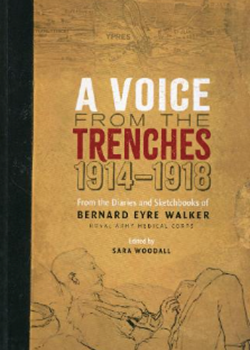A Voice from the Trenches 1914–18: From the Diaries and Sketches of Bernard Eyre Walker by Bernard Eyre Walker and edited by Sara Woodall
- Home
- World War I Book Reviews
- A Voice from the Trenches 1914–18: From the Diaries and Sketches of Bernard Eyre Walker by Bernard Eyre Walker and edited by Sara Woodall

(Blackthorn Press, 2020), £18.00, paperback, 192 pages with illustrations ISBN 978–1–906–25958–7
Bernard Eyre Walker’s diary was lost – not recently, as it has been known to be in the Liddle Collection for many years – but during the great retreat caused by the Kaiserslacht. It was returned to him some years after the war ended as the German soldier who found it passed it over to TocH.
Bernard was a stretcher bearer with a Field Ambulance and therefore moved casualties behind the lines, rather than in the Front Line, those expecting descriptions of life at the front may, therefore, be disappointed. The diary is in two parts as Bernard landed in France in December 1914, was wounded in May 1915 and didn’t return to the Western Front until 1917: it appears that he made only the briefest account of his time as a convalescent. There is a short section at the end, written from memory, describing what happened to Bernard during the retreat, followed by a section by the editor describing Bernard’s later life The author spent most of his war service in Belgium, part of it stationed at the casemates in the walls of Ypres. He seems to have spent very little time carrying stretchers but quite a lot travelling around in cars or motor ambulances. There are good descriptions of driving through Ypres at night to collect casualties during 1915. What is also surprising is that a fair proportion of his time was spent transporting Belgian civilians, both those injured by enemy shelling and ones who had fallen ill. The description of his evacuation to England on a hospital ship is interesting, and there are also mentions of unofficial truces that took place during 1915. What raises this volume above that of other published diaries is that, like his father before him, Bernard Eyre Walker was a well–known artist. His wartime sketches, aquatints and later watercolours appear throughout the book and make it obvious that Bernard could easily have been an Official War Artist if his talents had been recognised.
The editor has refrained from adding too many footnotes to Bernard’s words, mainly elucidating abbreviations. Occasionally a little more editorial input might have been useful: on 26 March a colleague pointed out to Eyre Walker a brigadier with whom he had joined up as a private in 1914. It didn’t take much work on the internet to discover that this was Lt–Col (Acting Brigadier) William Colsey Millward DSO and that, only two days later, he was wounded by a German shell, resulting in the amputation of his left leg! The book does appear to contain remarkably few errors – although the editor does exhibit the usual confusion between ambulances intended for transporting casualties and Field Ambulances at one point and doesn’t correct, or comment on, some of the incorrect medical beliefs of the time that are described.
Recommended, particularly for the artist’s contemporaneous illustrations, mainly in aquatint with later paintings reproduced in colour.
Review by Niall Ferguson
(This review first appeared in the April 2022 edition of Stand To! (No.126) The journal of The Western Front Association which is published four times a year and is sent to members in print and digital forms.)





